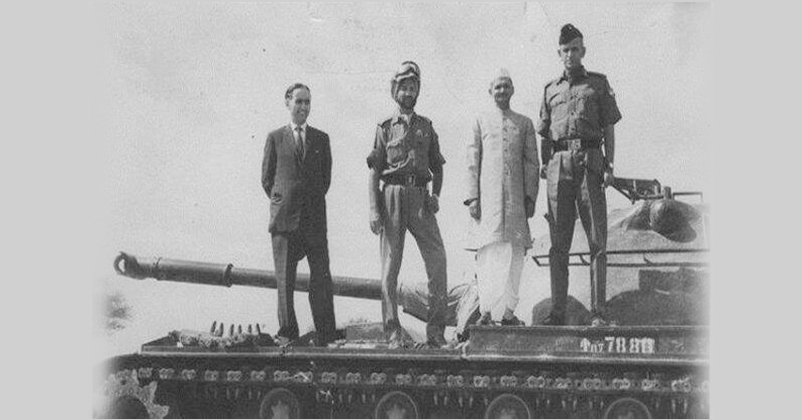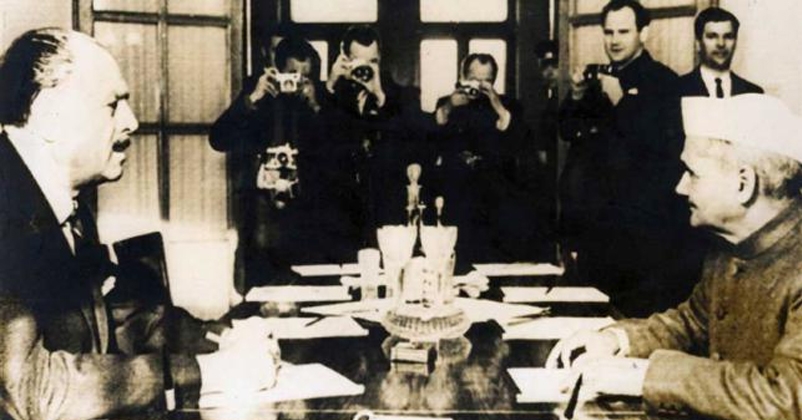The War of 1965 & The ceasefire between India-Pakistan
11 Sep 2020 21:51:13

After Nehru's death in 1964, there somewhat arose a political uncertainty in the country and Pakistan took the impression that India was no longer politically or militarily strong. While Pakistan's then Field Marshal Ayub Khan was entrenched in power he adopted a secret plan of armed infiltration into India misestimating Indian defence forces on several fronts. By 1965, the Pakistan Army as per the foul plan trained and poised itself to go on an offensive in the valley. The enemy carried out the invasion based on prime factors such as to test the political waters around May 1965 and to draw India’s forces away from Punjab, the main battlefront. Armed infiltration in J&K was launched with a motive to portray before the world that it was more of a local uprising. However, the main miscalculation on Pakistan’s part was to believe that the Kashmiris would help the infiltrators and rise against the established government. Another major miscalculation by the enemy was to presume that India will not counterattack in Punjab.
Battle in the Rann of Kutch
Pakistan had launched an armed operation in the Rann of Kutch in Sindh in January 1965, which continued to June 1965, and paved the way for Operation Gibraltar and then the full-scale war. Rann, one of the largest salt deserts in the world is a remote plain of coastal Gujarat that remains flooded with shallow salt waters for nearly six months in a year. Only a few small islands of dry land or ‘bets’ remain above the ‘water line’. The area gave Pakistan a chance to try out various new weapons supplied to them by the US as part of its Military Assistance Program and also to draw the Indian Army away from Punjab and Jammu & Kashmir.
Indian Army became aware in Jan 1965 of Pakistani border police who were patrolling below the Indian claim line. Pakistani patrolling south of Kanjarkot may have been going on for quite some time without the Indian forces knowing it. They moved forcefully against Indian outposts near the border fort of Kanjarkot. By the time, Indian troops came to know about regular patrols of the enemy in the claimed area, Pakistan had established post in the Kanjarkot area which further irked India. It was when India announced Pakistani aggression in the Rann of Kutch. After India lodged an official protest, it increased its own patrolling activity in the area, although the area full of wetlands was hard to patrol. In mid-Feb 1965, Pakistani forces thus found a way to dug themselves in around Kanjarkot, the area, which was previously unoccupied, even though Pakistan desperately claimed that it had long occupied it.
In strong retaliation, India moved large forces during March-April 1965 and established forward military posts carrying out full-scale land, sea, and air operation in its vicinity. Both sides built up the forces available to them in the area manned strong points and shifted defence responsibility from border units to the army. The Indian response of occupying other posts near the frontier and, building an airstrip nearby brought the latent crisis to a head with Pakistan increasing its strength of troops in area.
By second week of April 1965, the skirmishes between two armies turned into small scale battles. Pakistan while enjoying the militarily superior position, moved forcefully against Indian outposts near the border fort of Kanjarkot and garnered a little success in penetrating the Indian troops. On 08 April 1965, Indian forces attacked a Pakistan out-post at Ding in an endeavour to complete a military takeover of the territory. Shooting continued between patrols and strong points.

Ceasefire
Casualties were reported both sides as the incidences of shooting continued between patrols. On 19 April, Pakistani troops in the Rann of Kutch declared capturing of Biar Bet and came closer to cut right through to the Indian forces aiming two Indian brigades when they were held off from exploiting a favorable tactical situation. Pakistan by the end of April was forced to propose a ceasefire following an increasing international pressure, which India accepted; an agreement was signed, and the forces disengaged. A ceasefire was arranged in May 1965.
In June 1965, then British Prime Minister Harold Wilson persuaded both countries to end hostilities and set up a tribunal to resolve the dispute. On June 30, 1965, India and Pakistan signed an agreement that ended the battle in the Rann of Kutch. The agreement was signed separately in Karachi and New Delhi. However, partial success prompted Pakistan to move further. From its partial hold that the enemy enjoyed in Rann of Kutch, Pakistan somehow believed that the Indian defence forces could not stand two strong and timely blows. Thus, they planned to further test India and this time in the Valley through 'Operation Gibraltar' which further snowballed into full-fledged war which Pakistan lost severely.
Operation Gibraltar
Pakistan launched this operation believing that once they infiltrate in the valley, the Kashmiris will rise in large numbers against India, meanwhile, they can target the Indian Army to take control of the Valley. Operation Gibraltar was launched by Pakistanis in August 1965 with nearly 30,000 infiltrators including Pakistan Army regulars. However, Pakistan’s endeavour not only had failed miserably but also forced the enemy to open a front in Jammu so that their intruders could retreat safely. The war began on 1 Sept 1965, when Pakistan Army entered Chambh sector in Jammu & Kashmir.
The war of 1965 is considered to be one of the biggest wars fought by the Indian army, where it employed a large share of its resources. The Operation HQ for Operation Gibraltar was set up in Murree under Major General Akhtar Hussain Malik with approximately 30,000 men under his command, divided into eight to ten groups. The force was trained to infiltrate in nominated areas and overthrow the existing regime with the help of Kashmiri collaborators. The infiltrators were detected before they could carry out the intended coup. The information came from the Kashmiri natives themselves, who did not respond to this call of liberation. Pakistan at this stage had little mass support in the Valley and that is why this ingenious Pakistani plan failed.
The Indian counteraction against the various advance bases for Pakistani infiltration cut off the infiltrating columns. Now these columns were on the run, hunted by the Army and the local police alike. Pakistan at this stage started a full-fledged war by attacking Chhamb (Operation Grand Slam). After limited success, Operation Grand Slam also fizzled out and Pakistan had to go on the defensive, the Indian forces went on the offensive in Lahore Sector and reached the outskirts of Lahore.
This war taught Pakistan quite a few lessons. They now realized They now realized that they could not match the Indian Army in an open war and that all Indian people, Hindus, Muslims, Sikhs and Christians stood like a rock against Pakistan.
The Ceasefire between India and Pakistan
The then Secretary General of the United Nations, U. Thant, had been endeavouring ever since the Pakistani infiltration started into Jammu and Kashmir on August 5, to bring the battle to an end and to have the Ceasefire Line (CFL) respected by both sides. In his Report to the Security Council on September 3, he stated that on the advice of General Nimmo, the Chief Military Observer, he summoned the representatives of both sides separately. He asked the Pakistani representative to convey to his Government, his “very serious concern about the situation that was developing in Kashmir, involving the crossing of the CFL from the Pakistan side by numbers of armed men and their attacks on military positions on the Indian side of the line, and also his strong appeal that the CFL be observed”. He asked the Indian representative to convey to his Government, “my urgent appeal for restraint as regards any retaliatory action from their side”. Subsequently, the Secretary General reported that he was unable to get necessary assurance from Pakistan but received an assurance from the Indian representative’ that India would act with restraint and respect the CFL, if Pakistan did so.
U. Thant indicated in his Report that if a summary of CFL infractions was published, it would clearly put the blame on Pakistan. On September 1, the Secretary General publicly appealed for peace. He made personal visits to Rawalpindi and New Delhi during the period September 9-12, in his efforts to bring about a ceasefire. U. Thant wrote to both sides, suggesting a ceasefire at 6.30 p.m. on September 14. India requested for an extension of the time by 24 hours and accepted the proposal. However, then Indian PM Lal Bahadur Shastri stated that the ceasefire would apply to uniformed soldiers and that India would be free to deal with the infiltrators who were still within its territory. Pakistan, in its reply, continued to harp on her three-point demand including plebiscite. As the Secretary General could not accept any pre-condition from either side, the truce could not be achieved.
On September 20, the Security Council adopted a third resolution, demanding a ceasefire on the morning of September 22 and subsequent withdrawal of all armed personnel to the positions held on August 5. The Council also expressed willingness to consider the steps to be taken to assist towards a settlement of the political problem. Concurrently, the Council called on all States to refrain from any action which might aggravate the situation in the area.
India accepted the ceasefire but made it clear that it did not accept proposals regarding political settlement. The military situation compelled Pakistan to accept the ceasefire and restoration of status quo ante. Thus, at 3.30 a.m. on September 23 (I.S.T) the ceasefire came into effect.